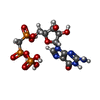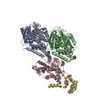+Search query
-Structure paper
| Title | Cytoskeletal regulation of a transcription factor by DNA mimicry via coiled-coil interactions. |
|---|---|
| Journal, issue, pages | Nat Cell Biol, Vol. 24, Issue 7, Page 1088-1098, Year 2022 |
| Publish date | Jun 20, 2022 |
 Authors Authors | Farah Haque / Christian Freniere / Qiong Ye / Nandini Mani / Elizabeth M Wilson-Kubalek / Pei-I Ku / Ronald A Milligan / Radhika Subramanian /  |
| PubMed Abstract | A long-established strategy for transcription regulation is the tethering of transcription factors to cellular membranes. By contrast, the principal effectors of Hedgehog signalling, the GLI ...A long-established strategy for transcription regulation is the tethering of transcription factors to cellular membranes. By contrast, the principal effectors of Hedgehog signalling, the GLI transcription factors, are regulated by microtubules in the primary cilium and the cytoplasm. How GLI is tethered to microtubules remains unclear. Here, we uncover DNA mimicry by the ciliary kinesin KIF7 as a mechanism for the recruitment of GLI to microtubules, wherein the coiled-coil dimerization domain of KIF7, characterized by its striking shape, size and charge similarity to DNA, forms a complex with the DNA-binding zinc fingers in GLI, thus revealing a mode of tethering a DNA-binding protein to the cytoskeleton. GLI increases KIF7 microtubule affinity and consequently modulates the localization of both proteins to microtubules and the cilium tip. Thus, the kinesin-microtubule system is not a passive GLI tether but a regulatable platform tuned by the kinesin-transcription factor interaction. We retooled this coiled-coil-based GLI-KIF7 interaction to inhibit the nuclear and cilium localization of GLI. This strategy can potentially be exploited to downregulate erroneously activated GLI in human cancers. |
 External links External links |  Nat Cell Biol / Nat Cell Biol /  PubMed:35725768 / PubMed:35725768 /  PubMed Central PubMed Central |
| Methods | EM (helical sym.) |
| Resolution | 3.89 Å |
| Structure data | EMDB-24721, PDB-7rx0: |
| Chemicals |  ChemComp-ANP:  ChemComp-GTP:  ChemComp-G2P:  ChemComp-MG: |
| Source |
|
 Keywords Keywords | MOTOR PROTEIN / Kinesin / Microtubule / Transcription factor / motor domain |
 Movie
Movie Controller
Controller Structure viewers
Structure viewers About Yorodumi Papers
About Yorodumi Papers





 homo sapiens (human)
homo sapiens (human)
